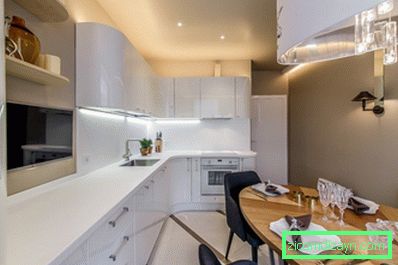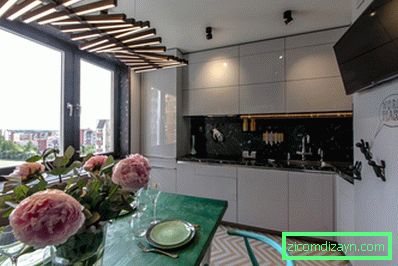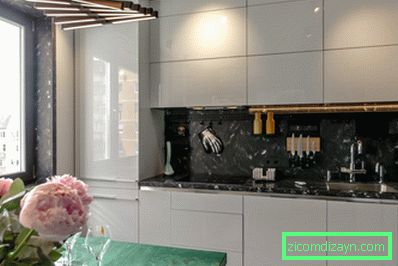Guide for the selection of artificial and natural stone for
Apron made of decorative artificial or natural stone - beautiful, expensive and almost eternal. However, he is not as invulnerable as it seems, and requires, first, a careful choice of finishing material, and secondly, the right care. From this article you will find out what artificial and natural stones are, what they have pluses and minuses, how to choose the least valuable mineral and how to take care of it. And to get ideas of design to you the selection of 40 photo interiors of kitchens with stone aprons will help.
See also our basic material: How to choose an apron for the kitchen - reference for the buyer
About artificial stone (agglomerate and acrylic)
For finishing the apron, two types of artificial stone are used - agglomerated and acrylic.
- Acrylic stone (corian) is a composite material made of acrylic resins, pigments and natural minerals. It is durable, but also more flexible and lightweight than agglomerated and natural stone, easily cleaned, mounted, repaired, cut to the desired shapes and sizes. However, Corian is sensitive to scratches and is afraid of contact with very hot objects. So, for example, from a hot cast-iron pot attached to the wall on an acrylic apron there can be a matte spot.

Acrylic stone in the finish of the apron of classic cuisine
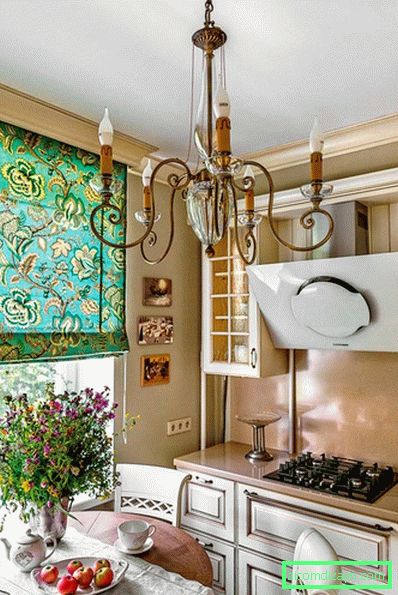
Acrylic stone in the finish of the apron of classic cuisine
- Agglomerate is a material that consists of natural minerals not less than 90%, everything else is pigments, decorative additives from glass / mirrors, and also binder - polyester resins. This composition makes the agglomerate super-strong, scratch-resistant, easy to care for (unlike natural stones), as natural as possible and more affordable. However, mounting, transporting, repairing and polishing an apron from an agglomerated composite is almost as easy as a stone apron. Even to the touch, the agglomerate is almost as cold as granite or marble.
In general, we can say that both acrylic and agglomerated stone is preferable to natural:
- Unlike natural minerals, acrylic and agglomerate do not have pores, and therefore are hygienic and unpretentious in care. In addition, unlike granite and marble, they are not afraid of acids. Neither beet juice, nor coffee, nor lemon will leave a trace on the apron under the stone.
- Artificial stone allows you to create monolithic structures without seams and to give the edges of the panel a beautiful figured shape, for example, in the form of a crown as in the photo below.
 This figured apron of agglomerate is 90% composed of natural quartz and silicon
This figured apron of agglomerate is 90% composed of natural quartz and silicon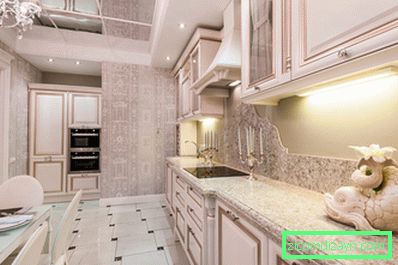 This figured apron of agglomerate is 90% composed of natural quartz and silicon
This figured apron of agglomerate is 90% composed of natural quartz and silicon
- Acrylic stone lends itself to local and complete repair. Scales, cracks, scratches and potholes are easily eliminated with a special glue for restoration, polishing and polishing.
- Externally, an artificial stone (especially agglomerate) is very similar to its natural prototype, it can be matte or glossy, have a uniform texture or a pronounced pattern with veins or impregnations.
- In a couple of "stone" apron can and should be picked up countertop made of the same material, as well as the windowsill and bar rack.
The disadvantages of acrylic stone include a high price (sometimes it can cost more than natural material), less strength and resistance to scratches, as well as artificial origin.
 Apron made from acrylic marble
Apron made from acrylic marble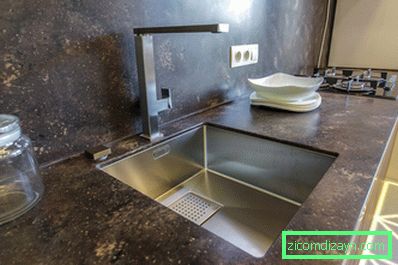 Apron made from acrylic marble
Apron made from acrylic marble Apron made from acrylic marble
Apron made from acrylic marble
Tips for the buyer:
- Choosing an apron of acrylic stone, give preference to light panels with a matte or semi-glossy surface and small impregnations. Against such background, scratches, drops of water, stains and dirt spots will be less noticeable. But the glossy aprons, especially in dark colors, will require you to double the cleaning, because they are visible even small specks, not to mention fingerprints.
- Do not wash the apron of artificial stone with hard brushes and sponges, as well as abrasive, alcohol and acid-containing cleaning agents.
- Polish the surface of the apron once in one or two years.
About natural stones
The main advantage of an apron made of natural stone is its natural and "living" beauty, which can not be recreated artificially. In addition, the stone is very durable and can last for years and centuries. In all other respects, natural minerals, unfortunately, lose to their imitations.
Firstly, because of the porous structure, all the stones absorb moisture to a greater or lesser extent, and together with it dirt, grease and pigmenting pigments from products. To prevent this from happening, stone surfaces must be treated at least once a year with siling - special protective impregnation for sealing the pores.
Secondly, they react to acids. So, for example, lemon spray can leave matte spots on the stone wall (can be seen at a certain angle). Other drawbacks of natural stones include their radioactive background (insignificant, but still), the presence of seams between slabs or tiles and, of course, a high price. And working with them is more difficult because of the severity and hardness. For example, to cut out a hole in the stone slab for a socket, you need a diamond-coated disc.

The shade, pattern and texture of each stone apron is unique and not handmade
The apron can be lined with three formats of natural stone: slabs, tiles and mosaic.
- Slabs are large slabs with a thickness of about 2 cm, which due to their dimensions allow you to not crush the natural pattern of a stone, but to represent it as completely as possible. Finishing the apron with slabs is the most spectacular and luxurious, but expensive and complex.

Marble slab in the decoration of an apron of modern cuisine in the LCD "Garden Quarters" in Moscow
- Stone tiles resemble ordinary ceramic tiles, because it also has standard sizes (30 × 30, 40 × 30, etc.) and sometimes requires a docking pattern. Stone in tiles is cheaper than slabs, it is easier to transport and fit. However, the apron of stone tiles has seams, which somewhat complicate its cleaning and require periodic renovation of the grout.
- Mosaic from natural stone is a mat with already laid out mini-tiles from one or several types of stones, sometimes in combination with tiles made of glass, ceramics, smalt and other materials. A picture of a mosaic made of stone can be as simple as it is very difficult - in the form of a panel.
 Kitchen mosaic apron made of stone, glass and ceramic tiles
Kitchen mosaic apron made of stone, glass and ceramic tiles Kitchen mosaic apron made of stone, glass and ceramic tiles
Kitchen mosaic apron made of stone, glass and ceramic tiles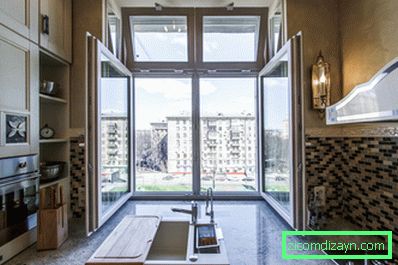 Kitchen mosaic apron made of stone, glass and ceramic tiles
Kitchen mosaic apron made of stone, glass and ceramic tiles Kitchen mosaic apron made of stone, glass and ceramic tiles
Kitchen mosaic apron made of stone, glass and ceramic tiles Kitchen mosaic apron made of stone, glass and ceramic tiles
Kitchen mosaic apron made of stone, glass and ceramic tiles
See also: All about the kitchen apron from the mosaic and even more
The most popular types of stones for cladding the kitchen apron are granite, marble, travertine.
Granite
Granite отлично подходит для отделки фартука, так как он очень твердый и плотный, а значит неприхотливый и износоустойчивый. Ни жир, ни пищевые красители вроде свеклы, ни чистка с щеткой, ни открытый огонь, ни мороз ему не страшны. Кроме того, гранит может быть подобран в нужном именно вам оттенке, ведь его палитра насчитывает почти тысячу тонов. Самый распространённый и недорогой гранит – серо-розовый, но вы можете выбрать зеленый, черный, коричневый, желтый, красный и даже белый камень.



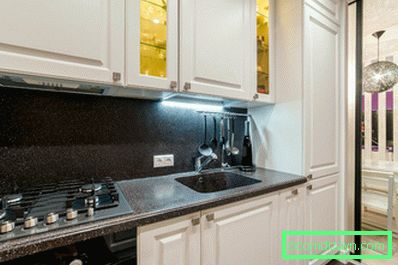

Marble
Marble – это, пожалуй, самый красивый и в то же время капризный камень. Он настолько не устойчив к кислотам, что даже пролитый кефир оставляет на нем матовые пятна. А из-за своей пористости и микротрещин мрамор очень быстро впитывает влагу, а значит и любые пищевые красители. Впрочем, если мрамор хорошо отполирован и пропитан гидрофобным составом, то красящие жидкости и продукты, скажем, кофе или свекла не будут так уж страшны. Главное - успевать удалять пятна и жидкости как можно быстрее и всегда иметь под рукой специальные средства для очистки мрамора.
 Apron of inexpensive domestic marble
Apron of inexpensive domestic marble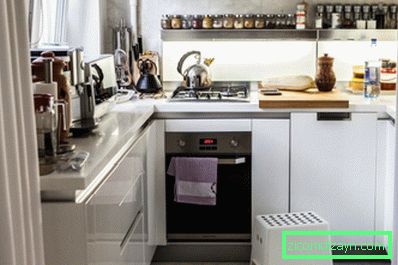 Apron of inexpensive domestic marble
Apron of inexpensive domestic marble
 Natural Stone
Natural Stone Natural Stone
Natural Stone

White kitchen with marble apron
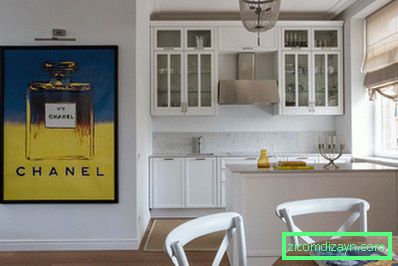
 Brown marble in the kitchen apron trim
Brown marble in the kitchen apron trim Brown marble in the kitchen apron trim
Brown marble in the kitchen apron trim Brown marble in the kitchen apron trim
Brown marble in the kitchen apron trim
Travertine
Travertine (известковый туф) – это промежуточное звено между известняком и мрамором, поэтому он имеет свойства, характерные для обоих минералов. Фартук из травертина прочен, не боится перепадов температур, огня. Однако он менее плотный, чем мрамор, и так же боится кислот и красящих продуктов/жидкостей. Чтобы фартук из травертина не пачкался и всегда хорошо выглядел, он должен быть идеально отполирован и обработан гидрофобной пропиткой, самополирующимся воском и мастикой.


Another difference between travertine is its variety of patterns and shades. The apron of this stone can be white, beige (the most common color), brown, rich red.
- By the way, the expensive natural travertine has a more budgetary alternative - a flexible stone consisting of a sandstone 1-2.5 mm thick, a binder polymer and a textile base. Externally, the apron of a flexible stone is practically indistinguishable from the original, it is unpretentious in maintenance, can last up to 40 years, is subject to local repair, and due to its softness and flexibility it is easy to install even without the help of specialists. The only drawback of flexible stone is a limited number of shades (only a few dozen). In addition, an apron of flexible stone requires the same care as aprons from slabs or tiles, that is, timely cleaning of liquids and treatment with protective impregnations once a year.


Tips for the buyer:
- When buying an apron made of stone, make sure that it is well polished. And before you start using it, soak the apron twice with protective impregnation and a brush (the first layer should dry completely).
- Processing a stone apron is needed about once a year.
- Acquire a natural stone only from proven manufacturers to avoid buying a mineral with high radioactivity.
- Laying tiles with stone, and especially marble or travertine, can only be entrusted to high-class professionals.
